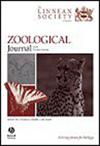Four-toed sengi (Petrodromus tetradactylus, Afrotheria, Mammalia) museomics reveals a crucial role of East African forests in macroscelidean diversification
IF 3
2区 生物学
Q1 ZOOLOGY
引用次数: 0
Abstract
Sengis (Macroscelidea) are members of the Afroinsectivora, a group of mammals belonging to the supercohort Afrotheria. Sengis’ low population densities and their distribution, which includes politically unstable regions with ongoing armed conflicts, hinder contemporary sampling of comprehensive datasets. We overcome this obstacle for the species Petrodromus tetradactylus, one of the most widely distributed sengi species, by utilizing 44 historical museum samples from multiple natural history museums. These historical samples were combined with newly generated or published data of 11 modern samples, thus creating a dataset of 55 P. tetradactylus individuals covering most of the species’ distribution. Phylogenetic reconstruction with 11 nuclear loci in conjunction with mostly complete mitochondrial genomes reveals multiple deeply divergent and formerly unknown lineages within this monotypic genus, highlighting the need for a taxonomic revision. Furthermore, we can show that the assumed allopatric distribution of P. tetradactylus in Central Africa most likely represents a sampling artifact. Biogeographic character mapping indicates that the African forest system and its dynamics through climate fluctuations shaped the evolutionary and biogeographic history of this taxon. We show that lineages within Petrodromus that were able to adapt to dryer woodland ecosystems are much more widely distributed than lineages restricted to moist forest systems. The evolution and radiation of the four-toed sengi (P. tetradactylus) mirrors the patterns of its distant relative, the giant sengis (Rhynchocyon) in both ecotype variation and overall distribution, implying a significant influence of climate and landscape features in shaping diversification.四趾猿猴(Petrodromus tetradactylus,非洲猿类,哺乳纲)缪斯组学揭示了东非森林在大型蛛形纲动物多样化中的关键作用
鼩鼱(Macroscelidea)是非洲食虫目(Afroinsectivora)的成员,属于超群非洲食虫目(Afrotheria)的哺乳动物。鼩鼱的种群密度较低,且分布在政治不稳定、武装冲突不断的地区,这阻碍了当代综合数据集的采样工作。我们利用来自多个自然历史博物馆的 44 个历史博物馆样本,克服了分布最广的森吉类物种之一 Petrodromus tetradactylus 的这一障碍。这些历史样本与新产生或已发表的 11 个现代样本数据相结合,从而建立了一个包含 55 个四手蟾个体的数据集,涵盖了该物种的大部分分布区。利用 11 个核基因位点和大部分完整的线粒体基因组进行的系统发育重建揭示了这一单型属中的多个深度分化和以前未知的世系,突出了对分类学进行修订的必要性。此外,我们还可以证明,假定四手蟾蜍在中非的同域分布很可能是一种取样假象。生物地理特征图显示,非洲森林系统及其在气候波动中的动态变化塑造了该类群的进化和生物地理历史。我们的研究表明,Petrodromus中能够适应较干燥林地生态系统的品系比局限于潮湿森林系统的品系分布更广。四趾仙履虫(P. tetradactylus)的进化和辐射反映了其远亲大仙履虫(Rhynchocyon)在生态型变异和总体分布方面的模式,这意味着气候和地貌特征对其多样化的形成具有重要影响。
本文章由计算机程序翻译,如有差异,请以英文原文为准。
求助全文
约1分钟内获得全文
求助全文
来源期刊
CiteScore
6.50
自引率
10.70%
发文量
116
审稿时长
6-12 weeks
期刊介绍:
The Zoological Journal of the Linnean Society publishes papers on systematic and evolutionary zoology and comparative, functional and other studies where relevant to these areas. Studies of extinct as well as living animals are included. Reviews are also published; these may be invited by the Editorial Board, but uninvited reviews may also be considered. The Zoological Journal also has a wide circulation amongst zoologists and although narrowly specialized papers are not excluded, potential authors should bear that readership in mind.

 求助内容:
求助内容: 应助结果提醒方式:
应助结果提醒方式:


